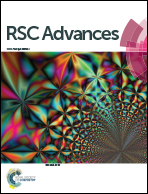Exopolysaccharide from psychrotrophic Arctic glacier soil bacterium Flavobacterium sp. ASB 3-3 and its potential applications†
Abstract
A novel exopolysaccharide (EPS) producing psychrotrophic bacterium Flavobacterium sp. ASB 3-3 was isolated from Arctic glacier soil and identified. The optimum fermentation conditions for EPS production were an initial medium pH of 7.2 and an initial inoculum size of 5% (v/v). The maximum yield of EPS (7.25 ± 0.26 g L−1) was obtained after cultivation at 25 °C for 120 h with glycerol as the sole carbon source. The EPS was purified and its structural characteristics were analyzed by 1H and 13C NMR. The predominant repeating units of this EPS are (α, β) D-glucose and D-galactose and it is different from the structure of EPSs produced by other Arctic and Antarctic bacteria, which have mannose units. In addition, EPS has demonstrated a comparable emulsifying property than SDS and flocculating properties with kaolinite, suggesting their potential applications in various industries. The EPS also significantly improved the tolerance of Flavobacterium sp. and Escherichia coli from freeze–thaw cycles, suggesting that it might be used to survive in polar regions and it can have possible usage as microbial cryoprotectants.


 Please wait while we load your content...
Please wait while we load your content...